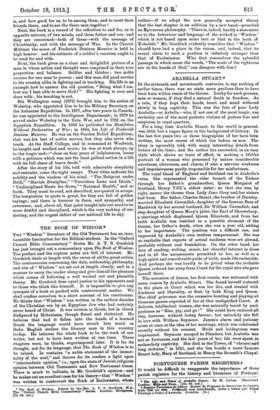ARABELLA STUART.* IN the sixteenth and seventeenth centuries, to say
nothing of earlier times, there was no state more perilous than to have been born within reach of the throne. Lucky for such persons, men or women, if they died a natural death in freedom. As a rule, if they kept their heads, heart and mind withered slowly in long captivity. This was the fate of poor Lady Arabella—or Arbella—who, if not one of the most tragic, wag certainly one of the most pathetic victims of jealous fear and suspicion in royal quarters.
For a long time Arabella, Stuart, to the world in general. was little but a vague figure in the background of history. In the last few years two or three biographies of her have been written, the most recent of which lies before us now. Tli,e story is agreeably, told, with many interesting details from letters of the time ; and the author has succeeded, in an easy style which shows no trace of effort, in making a lifelike portrait of a woman who possessed by nature considerable sweetness, cleverness, and charm, if also a nervous weakness and impulsiveness partly responsible for her misfortunes.
The royal blood of England and Scotland ran in Arabella's veins. She represented the elder branch of the Tudors through her father's grandmother, Queen Margaret of Scotland, Henry VIII.'s eldest sister : so that she was, by right, nearer the throne than Lady Jane Grey and her sisters had been. Her father, Charles Stuart, the brother of Darnley, married Elizabeth Cavendish, daughter of the famous Bess of Hardwick by her second husband, Sir William Cavendish, and step-daughter of Queen Mary's jailer, the Earl of Shrewsbury; a marriage which displeased Queen Elizabeth, and from her birth Arabella was watched as a possible claimant of the throne, her father's death, when she was a year old, adding to her importance. The position was a difficult one, not improved by Arabella's own restless temperament. She was so excitable that reports of actual madness were set abroa4, probably without real foundation. On the other hand, her love of reading, writing, music, her cheerful interest in dress and in all the amusements permitted to her, as well as a high spirit and considerable pride of birth, made life endurable. And perhaps she was hardly to be pitied when the irritable Queen ordered her away from Court for the royal airs she gave herself there.
The accession of James, her first cousin, was welcomed with some reason by Arabella. Stuart. She found herself restored to the place at Court which was her due, and treated with kindness and liberality, at first, by both King and Queen. Her chief grievance was the excessive bunting and playing.at tiresome games expected of her at that undignified Court. ,A. delicate, intellectual woman, she was naturally bored by such pastimes as "Rise, pig, and go !" She could have endured all this, however, without losing favour ; but unluckily she fell in love with William Seymour. James's alarm and jealousy arose at once at the idea of her marriage, which was celebrated secretly without his consent. Bride and bridegroom were imprisoned. Seymour escaped to Flanders, but Arabella was not so fortunate, and the last years of her life were spent .n melancholy captivity. She died in the Tower, of "chronic mad long sickness," in 1615, and she lies beside a more faraeps Stuart lady, Mary of Scotland, in Henry the Seventh's Chapel.














































 Previous page
Previous page